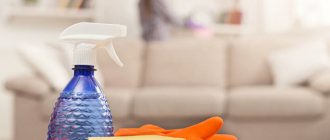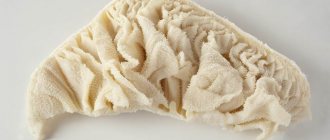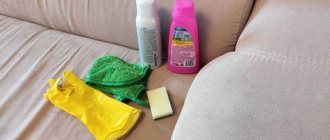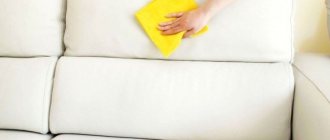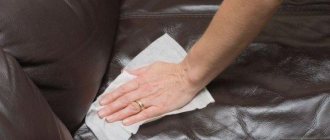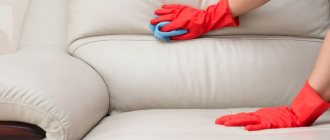Every housewife strives to keep all corners of her home clean. However, cleaning upholstered furniture can be challenging. To avoid damaging the expensive upholstery, you can have your sofa dry cleaned. However, if you know a few tricks, you can handle the cleaning yourself. One of the most successful and popular materials for sofa upholstery is flock. It is pleasant to the touch and resistant to rubbing. In addition, cleaning a flock sofa at home can be done using traditional and specialized detergents.
Features of flock cleaning
Furniture flock is a non-woven single-sided textile made from synthetic and natural fibers. It has a dense base with thick pile glued to it. The resulting upholstery does not tear or stretch. However, the material does not tolerate chemical exposure well. This may damage the adhesive layer and cause the top layer to fall off.
Therefore, flock is contraindicated:
- cleaning with pure alcohol and products based on it;
- use of benzene, acetone, gasoline and other organic solvents;
- the use of chlorine and other strong bleaches;
- spin;
- mechanical cleaning, which includes intensive scraping of old stains.
It is important to know! Regardless of the type of contamination, it must first be dissolved and then carefully removed. Otherwise, the pile may be damaged.
In order for the material to maintain a fresh and neat appearance longer, it needs regular dry cleaning. Therefore, flock furniture should be vacuumed at low power. This will remove dust and hair, but will protect the pile from stretching.
An excellent solution would be to use a steam cleaner. With its help, you can not only remove stains and dust, but also prevent the appearance of sofa mites. In addition, using a steam cleaner brightens the appearance of upholstery fabric and also eliminates unpleasant odors.
Ironing
Colored and plain items need to be ironed correctly. Initially, the housewife reads the instructions written on the label. Manufacturers leave recommendations for buyers; information about ironing is often included. In the absence of labels, standard rules regarding synthetic fabrics apply.
It is recommended to transport flock rolled up. It is harmful to fold the fabric in several layers - obvious stripes will remain. If you handle artificial material correctly, there will be no problems. The item will retain its color for a long time and preserve its original appearance.
Methods for cleaning upholstered flock furniture
If you follow the basic rules of care, cleaning flock at home is quite simple. Regardless of the method chosen, it is extremely important to use plenty of water. The basis of upholstery fabric is glue, which can simply come apart if it gets too wet. And after cleaning, you should walk over the surface of the sofa with a special soft brush to fluff up and even out the pile.
Mechanical
The easiest way to clean flock upholstered furniture is to use a vacuum cleaner with a special soft furniture attachment. If you do this regularly, the need for general cleaning can be postponed for a long time. However, sooner or later more serious cleaning will still be required.
Physical
The physical method will require a sheet, a beater or other device and a little time. Main stages:
- cover the sofa with a wet sheet;
- choose carefully;
- when the sheet becomes dirty, change it;
- thoroughly clean with a brush any animal hair, hair and large debris that remains on the surface;
- let dry.
Knocking out should be done very carefully so as not to damage the pile or deform the upholstery.
Chemical
If you need to clean your sofa from serious dirt and remove unpleasant odors, it is recommended to use dry cleaning. To do this, you can use various specialized products or regular washing powder. It is extremely important to apply the product to the entire surface of the sofa to avoid light stains.
If the contamination is light, you can use a regular soap solution. It must be prepared in a separate container and then applied to all upholstery fabric using a soft brush. After washing, it is necessary to remove foam and soap with a damp cloth so that it does not leave stains or streaks.
Chemical methods also include the use of laundry soap, which can remove even serious stains. First, it should be crushed using a fine grater and mixed with warm water.
However, in case of serious stains, it is better to refuse to care for floss upholstery yourself. It is better to entrust the work to professionals who guarantee the choice of optimal cleaning products and care methods.
Drying
Housewives are interested in the drying process. It is important to immediately bring armchairs and sofas into a condition suitable for use. It is allowed to leave furniture and pillow covers until completely dry. It is important to avoid exposure to sunlight, as they lead to fading of the fabric. It is useful to open the windows to provide a flow of fresh air. Drying time depends on the size of the item, the intensity of cleaning, and the amount of liquid used.
It is not recommended to squeeze delicate materials too hard. Excess water is carefully removed from them, otherwise the original shape will be lost. The product is given its original shape and dried in this form.
The surface of the sofa can be easily dried using a hairdryer. A weak mode is used, the air is cold or slightly warm. The hairdryer should not be brought close to the sofa, otherwise the surface will be damaged. It is important to monitor the heating of the device. If the hair dryer becomes overheated, it turns off. After some time, the procedure is repeated.
Even if you dry the flock correctly, it becomes hard and disheveled. The pile is smoothed with a sponge or soft brush. You should move in the right direction. When the procedure is carried out correctly, the material looks like new.
How to properly wash organza items
Some types of flock cannot be washed. Manufacturer's recommendations can be found by looking at the label. As a last resort, delicate washing is allowed, otherwise there is a chance of ruining the upholstery and spoiling the appearance of the product itself.
Removing various contaminants
Even regular cleaning of flock furniture does not prevent the formation of stains. The method of their removal will depend on the nature of the contaminants. You should choose a detergent based on these indicators, but first check it on an inconspicuous area of the sofa.
Oily stains
The easiest way to remove grease stains is to use a soap solution. With its help, you can remove even old grease stains without the risk of damaging the upholstery. However, you should not apply soap directly to the sofa, but first prepare a solution based on it. To do this, you can use both liquid soap and grated soap. After that, a concentrated solution should be prepared based on it and applied to the stain. Leave on for just a few minutes, then rinse off with a damp cloth. After removing the stain, you need to thoroughly dry the sofa so that there are no streaks left.
To combat serious grease and grime stains, you can use dishwashing detergent. It should be diluted slightly with water and applied to the problem area. If necessary, you can rub it a little into the upholstery in a circular motion.
Important! Do not use a hairdryer to dry the flock, otherwise the dried area may differ in color. It is better to dry the upholstery with a towel or naturally.
Blood
Removing blood stains is a fairly complex process. It is best to remove a fresh stain. To do this, simply wipe the problem area with a sponge dipped in cold water. For old stains, you will need to use a vinegar solution with added soap. After the procedure, you should wash the flock on the sofa in the usual way so that the cleaned area does not differ in color from the rest.
Wine
Red wine stains can be difficult to remove. First, blot the fresh stain with a paper napkin so that its size does not increase. Then you should sprinkle the area with salt, which will absorb moisture, and after a few minutes, clean the dirt with a soft brush. All that remains is to wipe the area with a damp cloth. When the area dries, you should wipe the area again with a soft brush to straighten the pile.
Urine
If there are animals in the house or a child who is just potty training, urine stains and an unpleasant odor may appear on the sofa. Before cleaning the sofa, the stain should be dried. In this case, it is prohibited to use a hair dryer. The best solution is to use a paper or cloth towel. Then you need to apply a soap solution to the surface, which will eliminate the unpleasant odor and remove the stain.
An alternative is to use baking soda. You need to pour it directly onto the stain and wait until it absorbs the urine. Remove soda and disinfect the surface with a weak solution of potassium permanganate. However, if the sofa is light, using potassium permanganate may result in pink spots.
Felt pen, pencil, paints
Traces of children's creativity can be removed from the sofa using a weak alcohol solution. Soak a cotton pad in it and gently rub it over the dirt, then thoroughly wash the area with a damp towel.
Ice cream
To remove traces of cold treats, use a sponge dipped in a soap solution. If the stain is fresh, a few seconds are enough, but if it is old, you need to wait until it softens.
Wax and chewing gum
Finding chewing gum or candle marks on your favorite sofa can seem tragic. However, there is an easy way to remove them. To do this, you need to apply an ice cube to the problem area, which must first be wrapped in film. When the gum or wax has completely hardened, you can remove it with any hard object. After the procedure, all that remains is to straighten the pile so that it returns to its previous position.
Dust
If you do not regularly dry clean a flock sofa, a lot of dust will accumulate on its surface, which will penetrate deep into its structure. This leads to darkening of the product and the formation of stains on it. In this case, one vacuum cleaner will not be enough.
An excellent solution is to use a washing powder solution that is designed for machine washing. This product does not foam much, which makes it easier to wash off the solution. Apply the mixture for 15-20 minutes, then rinse with damp cloths.
Bleaching things
The whitening procedure is not suitable for all items. It uses aggressive substances that spoil the material. Flock cannot be bleached; it will lose its quality, turn pale, and fade. It is recommended to take care of it initially, preventing loss of color, yellowing, and the appearance of a gray tint.
You can refresh the fabric by going over it with a vacuum cleaner. It is useful to use a soft brush that does not damage the structure. It will remove the accumulated layer of dirt and dust. This procedure is not relevant for significant contamination. They require hand washing, using a soap solution and a sponge.
Bleaching things
Professional dry cleaning of sofas
Professional dry cleaning can also solve the problem of cleaning flock sofas. This will minimize the risk of damage to the fabric, and also guarantee high quality cleaning and removal of even the most difficult stains. By contacting our company, you can order flock sofa cleaning services at home. The benefits of professional cleaning include:
- use of environmentally friendly and safe cleaning products;
- high speed of work;
- affordable cost of all types of services;
- guarantee of preservation of the external qualities of even the most sensitive upholstery;
- use of professional equipment.
By contacting our company, you can order high-quality cleaning of flock sofas at the best price.
What kind of fabric is this?
Flock is one of the most popular upholstery fabrics for upholstered furniture, characterized by ease of use, long service life and low price.
Flock is a finely chopped pile that is glued to the fabric. According to tactile sensations, the flock is soft. Depending on the shape and length of the pile particles, the material can have a different original texture, reminiscent of artificial velvet, velor, plush or boucle. It features a modern design and a large number of colors.
Important! The flock composition is 100% nylon pile, less often nylon, and a base consisting of 65% polyester and 35% cotton.
Chemical
This method helps to cope well with various types of contaminants.
Important! Observe the quality of the cleaning product used, the concentration, time and quantity, otherwise traces may remain that will subsequently be impossible to remove, or the fabric will become discolored.
Method 1
One of the easiest options when deciding how to clean the flock on a sofa at home, since the necessary products and tools will certainly be at hand:
Important! When using the brush, make sure it is damp, not wet. There may be unwanted stains on the sofa.
Method 2
Lemon juice works very well for removing food stains. But it is better to use it on light-colored upholstery, since lightened stains may remain on dark fabric.
Here's how to properly clean flock on a sofa with this product:
Method 3
Laundry soap - this product always helps out, in all cases, and the situation when you need to clean the flock on the sofa is no exception. For this:
Important! After treating with soapy water, comb the pile to give it volume.
Method 4
If lipstick, a pen, or a pencil suddenly gets on the surface of your sofa, don’t worry, regular 10% alcohol can handle it.
Soak a cotton pad in the solution and treat the surface. It is possible that the contamination remains, repeat the procedure until it completely disappears.
Method 5
For many things, chewing gum is a bit of a mess, but don't worry, here you can use ice:
Method 6
Dishwashing liquid does a good job of removing greasy stains and is an excellent option for cleaning flocking on your sofa. It is applied like this:
Important! Since the main function of such a product is to remove grease from dishes, it works in the same way on fabric. Accordingly, this option is best suited if you need to clean the flock on the sofa from oil stains and greasy marks after dinner on upholstered furniture.
Method 7
If you have a washing vacuum cleaner with special attachments for cleaning upholstered furniture, it is also quite suitable for solving the problem of restoring the attractiveness of the flock on the sofa. When using it, follow the instructions from the equipment manufacturer.
Important! It is not at all necessary to add auxiliary cleaning agents.
Method 8
This method is suitable for sofas with different types of upholstery, you just need to choose the right cleaning product from the line of offered manufacturers:
Important! Now they sell “Vanish for carpets”, which does not need to be diluted. Sprinkle it, wait twenty minutes and vacuum it up. There is one drawback, the smell will remain.
A flock sofa looks very attractive. The soft upholstery is pleasant to the touch, and the material itself is highly durable and elastic. But, as with any furniture, various stains can appear on the flock, sometimes difficult to remove. Then the owner has a question: “How to clean a flock sofa and not spoil its appearance?”
To wash or not to wash?
Modern fabrics used for furniture are very often artificial materials, which allows them to retain greater resistance to wear, maintain their original shape, avoid contamination, and all this at a practically low cost. However, no matter how stain-resistant today's synthetic-based fabrics are, eventually there is a need to clean them. As for the options for using furniture materials, in addition to upholstery, they serve as curtains, pillowcases, decorative pillows, bedspreads in the bedroom and other interior accessories. And if the sofa does not allow you to wash the stain, then in the case of objects and curtains you cannot do without washing.
By the way, to make washing and cleaning much more convenient, a separate type of upholstered furniture with removable covers was developed. Its use makes it possible, if not to wash the cover completely, then at least to take it to dry cleaning, which is much more problematic to do with a whole sofa.
However, owners of non-covered upholstered furniture
Also, don’t be discouraged - there are many professional cleaners who clean the customer’s home.
So, in order to avoid the need for washing and furniture cleaning as much as possible, you should think about which sofa to choose before purchasing. First of all, it is necessary to choose a material with special characteristics; these can be various types of compositions, impregnations, or even leatherette, the care of which is limited to wiping with a wet cloth.
You can also choose covered furniture or order a cover yourself, which will give you the opportunity to sometimes refresh an interior item using dry cleaning. And, of course, the issue of washing materials remains unanswered. Is it washable
fabrics that are furniture?
What mode and detergent do you use? How often can this washing be done?
The answers to all these questions are extremely simple and logical.
So, any woven materials can be exposed to wetness, which means they can be washed. And all non-woven materials for furniture have a woven base and, based on this, they can also be washed
.
BUT! There are many things to consider:
- Water temperature. It is best to use water at 20 degrees. Synthetic-based fabrics are very prone to shrinkage.
- Loading. All fabrics used for furniture have a lot of weight when wet, and the point is not in their structure or composition. The point is that objects made from furniture fabrics are already quite large in themselves. This is actually why you need to watch how heavily the machine is loaded, because washing machines for household needs are simply not designed for washing furniture covers. Excessively heavy laundry can damage the machine. At the same time, careful washing of curtains (one piece at a time) can be done independently without the help of dry cleaning.
- Detergents. It is logical to use gentle products for wool and silk; this will help protect artificial fibers, glue (for example, if we are talking about geotextiles with a base) and eliminate potential shrinkage. You should not use additional products (climate control, bleach) as their effect on artificial fabric is difficult to predict.
- The frequency of washing depends on what you want, but do not overdo it. After all, from frequent washing, each material can lose its original appearance.
- Separate wash for colored and light-colored fabrics.
- Spin. If a gentle wash is set from the very beginning, then the spin cycle will be appropriate. This will make it possible to avoid creases on the fabric, because fabrics used for furniture cannot be ironed.
The Textile Plus company is deservedly proud of its own range of furniture materials and no matter which one you choose, remember - washing fabrics labeled “furniture” should not be done frequently, reinforced and with harsh detergents. Otherwise, it is possible, the main thing is very carefully.
Who is Flock Attack on Titan?
Flock Forster (フロック・フォルスター Furokku Forusuta?) is a soldier who joined the Survey Corps from the Garrison and participated in the operation to liberate Wall Maria. The only one to survive the Beast Giant's stone barrage.
Interesting materials:
How is sick leave paid if there is no work experience? How is sick leave paid to an employee? How is a work patent paid? How do you get paid for working on a day off? How do they pay for a session at work? How are maternity pay paid at work? How are holidays paid if you don't work? How to pay for work on weekends and holidays? How to determine work experience If you worked part-time? How to refuse a job candidate?
Wash
This material is washable
and if you follow some instructions, washing will not affect the high properties of the fabric in any way:
- If the cover has zippers, they must be closed before washing. This is done so that the zipper does not damage the material during washing.
- It is better to wash the material in the gentle washing mode; this recommendation will make it possible to preserve all the properties of the fabric.
- When washing, it is better to use a solution of liquid soap.
- It is not recommended to use bleach when washing.
- The water temperature when washing should be no more than 40 degrees Celsius.
- After washing, the fabric can be ironed, but on the reverse side, and the temperature should not exceed 100 degrees Celsius.
- If the pile becomes slightly wrinkled during drying, this can be corrected by steaming. To do this, you need to take an iron with a steamer; the distance between the iron and the fabric should not be less than 10 cm.
